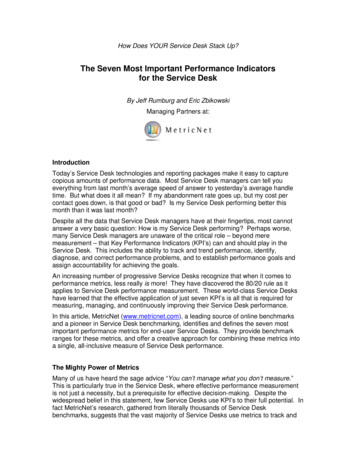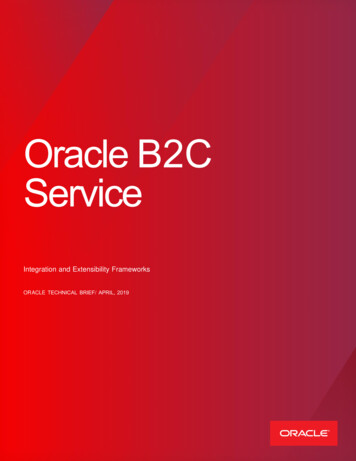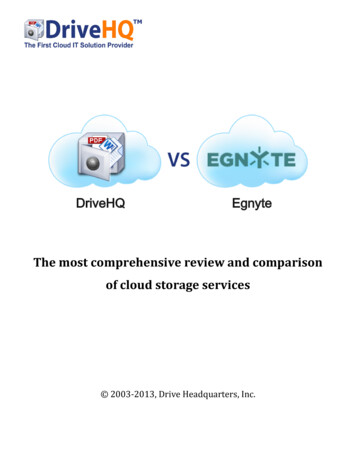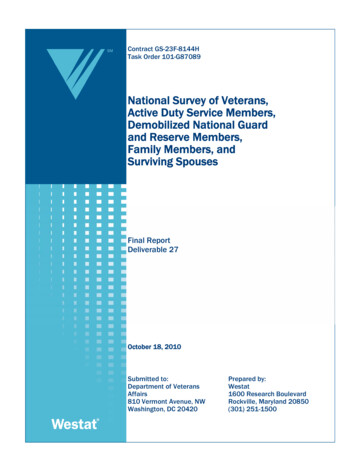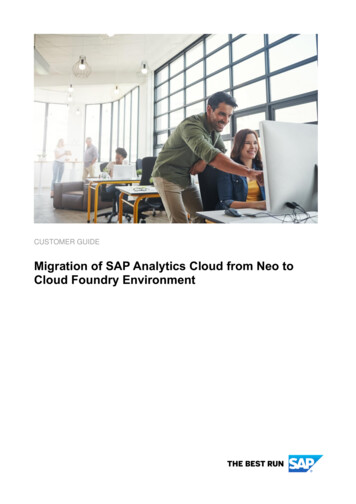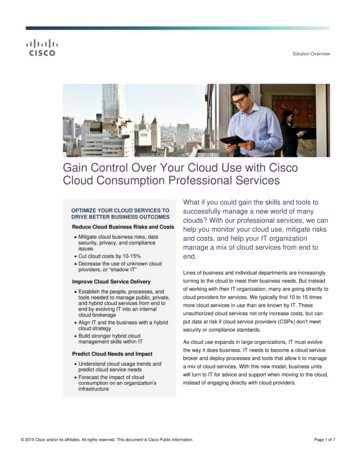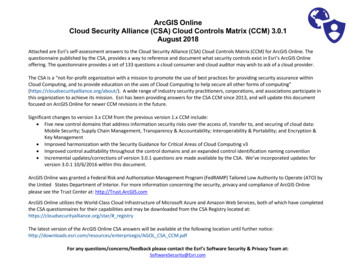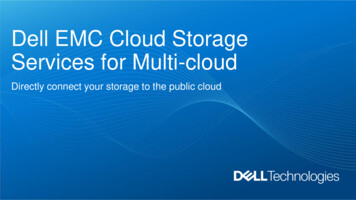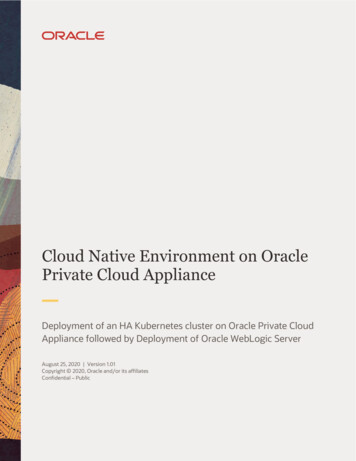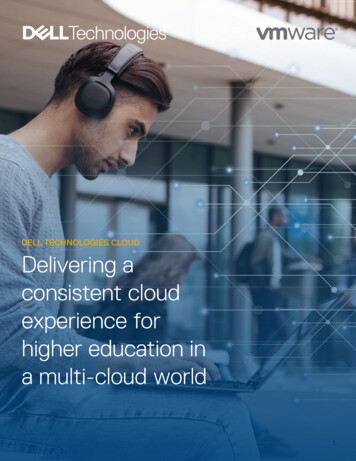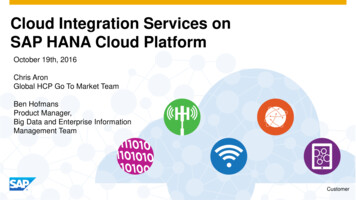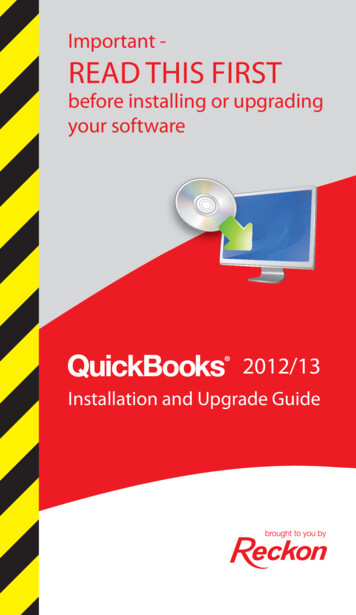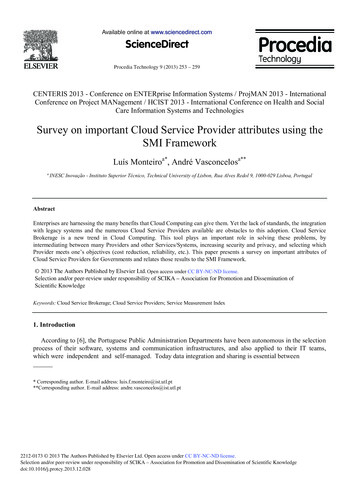
Transcription
Available online at www.sciencedirect.comScienceDirectProcedia Technology 9 (2013) 253 – 259CENTERIS 2013 - Conference on ENTERprise Information Systems / ProjMAN 2013 - InternationalConference on Project MANagement / HCIST 2013 - International Conference on Health and SocialCare Information Systems and TechnologiesSurvey on important Cloud Service Provider attributes using theSMI FrameworkLuís Monteiroa*, André Vasconcelosa**aINESC Inovação - Instituto Superior Técnico, Technical University of Lisbon, Rua Alves Redol 9, 1000-029 Lisboa, PortugalAbstractEnterprises are harnessing the many benefits that Cloud Computing can give them. Yet the lack of standards, the integrationwith legacy systems and the numerous Cloud Service Providers available are obstacles to this adoption. Cloud ServiceBrokerage is a new trend in Cloud Computing. This tool plays an important role in solving these problems, byintermediating between many Providers and other Services/Systems, increasing security and privacy, and selecting whichProvider meets one’s objectives (cost reduction, reliability, etc.). This paper presents a survey on important attributes ofCloud Service Providers for Governments and relates those results to the SMI Framework. 2013 The Authors Published by Elsevier Ltd. Open access under CC BY-NC-ND license. 2013 Published by Elsevier Ltd. Selection and/or peer-review under responsibility ofSelection and/or peer-review under responsibility of SCIKA – Association for Promotion and Dissemination ofCENTERIS/ProjMAN/HCIST.Scientific KnowledgeKeywords: Cloud Service Brokerage; Cloud Service Providers; Service Measurement Index1. IntroductionAccording to [6], the Portuguese Public Administration Departments have been autonomous in the selectionprocess of their software, systems and communication infrastructures, and also applied to their IT teams,which were independent and self-managed. Today data integration and sharing is essential between* Corresponding author. E-mail address: luis.f.monteiro@ist.utl.pt**Corresponding author. E-mail address: andre.vasconcelos@ist.utl.pt2212-0173 2013 The Authors Published by Elsevier Ltd. Open access under CC BY-NC-ND license.Selection and/or peer-review under responsibility of SCIKA – Association for Promotion and Dissemination of Scientific Knowledgedoi:10.1016/j.protcy.2013.12.028
254Luís Monteiro and André Vasconcelos / Procedia Technology 9 (2013) 253 – 259different organisms inside one organization. This decentralization inherited by the previous IT managementmodel made this task very difficult, requiring even more systems to mediate data sharing and systemintegration, which require more staff to code and maintain those systems. This led to more public spending onIT resources and personnel.To solve this and other problems, [6] mentions many strategies and changes to achieve a much moreefficient and less costly Government IT. Among those strategies, migration of systems to the Cloud issuggested as for cost reduction and, at the same time, enhance flexibility and adaptability of IT infrastructure.The adoption of Cloud Computing has a savings prediction around 4 million Euros in IT expenditure, having acost of around 2 to 2.5 million Euros. It also has benefits in the standardization of IT among many Governmentdepartments and impact on the economic growth.To apply a Cloud solution in an efficient way and with cost and risk reduction/mitigation and trust in mind,a Cloud Service Broker is a central piece on this strategy. The Broker achieves those benefits by providing away to standardize data used by the applications to work with the broker, which then translates that data to thedifferent Cloud Service Providers. This reduces the risk of vendor lock-in, as well as provides greater dataredundancy, by using many different providers to store data, assuring it is backed up and available at all times,even if one provider has some kind of failure. The broker is also important in the selection of the best providerfor each service requested made by an application, and can make that selection based on many criteria, whichcan be different for each application and/or user group.This Paper starts by giving a brief presentation of the Related Work on this subject (Section 2), followed bythe proposed solution (Section 3) and the results and conclusions that have been accomplished so far (Sections4 and 5).2. Related WorkThis section presents the state of the various areas of interest for this research. First, a brief introduction ofthe concept of SOA is presented. Afterwards, we’ll introduce the concept of Cloud Computing, the servicesinvolved and deployment models. Finally, there is an introduction to the main topic for this work, CloudService Brokerage, and the related existing technologies.2.1. SOA Applied to Cloud ComputingThe Service-Oriented Architecture (SOA) is a group of methodologies and principles in softwareengineering and systems architecture that defines a way to develop software and systems as a service. Theadvantage in making services is to abstract the complexity behind them and providing an easier way fordifferent applications to interact between them.SOA software follows a modular construction and have their components loosely coupled. This permits thatdifferent services be coded in different programming languages, be implemented/installed in different operatingsystems and still being able to communicate with each other.In order to interact with the services available, there is a contract associated with each service. This contractestablishes how one system/application can communicate with a given service. According to [11], the CloudService Broker concept inherits some characteristics from the Service Broker concept in SOA, namely in thecomparison and ranking of available Services, in order to provide better information for a correct choice ofService, as well as providing Service Level Agreement (SLA) negotiation. In the case of Cloud Computing,due to the frequent changes in Service quality and conditions, this last function is even more important, andalso harder to do.
Luís Monteiro and André Vasconcelos / Procedia Technology 9 (2013) 253 – 2592552.2. Cloud ComputingDue to the fact that Cloud Computing is a recent area of study by the scientific community, many definitionshave been proposed by several authors on many publications. We adopt the NIST’s definition for CloudComputing [4], which says: “Cloud computing is a model for enabling ubiquitous, convenient, on-demandnetwork access to a shared pool of configurable computing resources (e.g., networks, servers, storage,applications, and services) that can be rapidly provisioned and released with minimal management effort orservice provider interaction.”The Cloud follows a model called the SPI Model (SaaS, PaaS, and IaaS). This model goes from the lesscomplexity of implementation (SaaS) and more optimized service to a more complex to implement service(IaaS), but more flexible on its uses. PaaS is the middle term, providing more flexibility than the first, but beingless complex than the second. We can define these three types as follows, according to [4]:Table 1. Cloud Service Types.Service TypesDefinitionInfrastructureas a Service(IaaS)The capability provided to the consumer is to provision processing, storage, networks, and other fundamentalcomputing resources where the consumer is able to deploy and run arbitrary software, which can includeoperating systems and applications. The consumer does not manage or control the underlying cloudinfrastructure but has control over operating systems, storage, deployed applications, and possibly limitedcontrol of select networking components (e.g., host firewalls).Platform as aService (PaaS)The capability provided to the consumer is to deploy onto the cloud infrastructure consumer-created or acquiredapplications created using programming languages and tools supported by the provider. The consumer does notmanage or control the underlying cloud infrastructure including network, servers, operating systems, or storage,but has control over the deployed applications and possibly application hosting environment configurations.Software as aService (SaaS)The capability provided to the consumer is to use the provider’s applications running on a cloud infrastructure.The applications are accessible from various client devices through a thin client interface such as a web browser(e.g., web-based email). The consumer does not manage or control the underlying cloud infrastructure includingnetwork, servers, operating systems, storage, or even individual application capabilities, with the possibleexception of limited user-specific application configuration settings.The NIST [4] also defines the types of Cloud one can find:Table 2. Cloud Deployment Types.Cloud TypesDefinitionPrivate CloudThe cloud infrastructure is operated solely for an organization. It may be managed by the organization or a thirdparty and may exist on premise or off premise.CommunityCloudThe cloud infrastructure is shared by several organizations and supports a specific community that has sharedconcerns (e.g., mission, security requirements, policy, and compliance considerations). It may be managed bythe organizations or a third party and may exist on premise or off premise.The cloud infrastructure is made available to the general public or a large industry group and is owned by anorganization selling cloud services.Public CloudHybrid CloudThe cloud infrastructure is a composition of two or more clouds (private, community, or public) that remainunique entities but are bound together by standardized or proprietary technology that enables data andapplication portability (e.g., cloud bursting for load-balancing between clouds).2.3. Cloud Service BrokerageDue to many providers that exist in the Cloud (storage, computing, or other services), as well as the differentarchitectures designed for this purpose, many risks arise. Vendor lock-in because of the different APIs used bythe Cloud Services Providers (CSPs), the acquisition of services from different providers requiringcoordination, ensuring a higher level degree of security of data and information in the Cloud and the adoption
256Luís Monteiro and André Vasconcelos / Procedia Technology 9 (2013) 253 – 259of different architectures are some examples. To address all these problems, the Cloud Service Broker wascreated, serving as an intermediary between the firm and the Cloud Services it has acquisitioned. Thissubchapter will explain in further detail what Cloud Service Brokerage is and how it is generally designed.1) General Architecture: The architecture of a Cloud Service Broker varies among different developers andintegrator companies.We can further describe the Cloud Service Broker components, according to [9], as follows. Please, alsorefer to [9] for a schematic of the architecture described below:Table 3. Cloud Service Broker ComponentsComponentDefinitionCloud ServiceConsumerInterfaceThis component of the Cloud Service Broker receives Cloud Service Requests from the Cloud ServiceRequesters/Consumers. Also, when given an answer by the Cloud Services, it sends back the answer to therespective Requester/Consumer.Cloud ServicePublishInterfaceThis interface publishes subscriptions to the Cloud Services provided by the Cloud Service Providers. Afterreceiving a notification from a given Provider, its respective information is published in the Cloud ServiceBroker so it is available to the Requesters/Consumers. This subscription can also be synchronized with therequests from the Requesters/Consumers group. When a request is received, a subscription is sent to theProviders and then the Cloud Service Broker chooses the most suitable Cloud Service Provider to satisfy therequest.This component is responsible for processing the requests, finding in the Broker’s database which Services touse, translate the request to each Provider needed to satisfy that request, receive their answer, translate it for theRequesters/Consumers and send the response to them. It also can perform several other activities, such asSecurity Services, QoS and SLA Management, Composition Services, etc.It is responsible for mapping the requests received by the Cloud Service Broker to the respective Cloud ServiceProviders able to satisfy those requests. Also has information needed to connect to those Providers, like APIs,Communication Protocols, etc.Cloud ServiceProcessCloud ServiceAdapter2) SMI Framework: The Service Measurement Index Framework, abbreviated SMI, is a recent development bythe Cloud Services Measurement Initiative Consortium (CSMIC) and is now on version 1.0, presented to thepublic around September 2011. This framework is being developed in an attempt to create a standard formeasuring the quality of Cloud Services in general, allowing for a better choice by their potential clients. It’s ahierarchical framework, constituted by seven categories and with each category having three or more attributes.Each attribute will have also a set of Key Performance Indicators (KPIs), which are currently underdevelopment for a next version of the SMI Framework. For further information on this framework and adescription of the attributes, please refer to [12]. One gets the ranking of a given Provider by choosing theattributes that most resemble one’s necessities, and by giving weights to each attribute. Then the overallranking for that Provider is given by calculating the individual scores for each attribute and calculating thoserankings with basis on their weights.3. Solution’s ArchitectureWe propose the implementation of a Cloud Service Broker using the open source projects Aeolus Projectand Deltacloud, ensuring easy migration between providers by using a common template definition language. Itprovides a web interface to manage Images, Deployables, Providers and their Accounts, between otherfunctionalities. We will develop a provider ranking algorithm that will make an informed decision on whichprovider to use on a service request. This solves many migration problems, and the provider choice process.Following the steps that constitute the Design and Development Research Methodology, this solution can bedivided in several steps.The proposed solution’s implementation will start by assembling a list of requirements that must be met bythe Cloud Service Broker (Step 1), followed by a selection of the most important attribute in the SMI
257Luís Monteiro and André Vasconcelos / Procedia Technology 9 (2013) 253 – 259Framework (Step 2). Afterwards the Ranking Table will be constructed and an attempt on automation of certainattributes will be made, using the SMI Cloud Framework (Step 3). Finally, the prototype will be developed inthe form of a plugin for the Aeolus Project [3] that will use the Ranking Table to provide some decisioncapacity between different Cloud Service Providers. Then, tests and validation will occur to assure that thesolution works as predicted (Step 4).Fig. 1. Detailed View of the Cloud Service Broker Architecture and Interactions.4. Survey Data and ResultsA survey has been created to obtain community feedback on which attributes they found important for aProvider and their respective weights to be used in the SMI Framework (Step 2). This survey consists of 39ranking questions (related to 24 attributes and 7 categories, which might have more than one questionassociated), similar to the one that follows, and 2 open answer questions to clarify any answer to the previousquestions, as well as some questions to identify the type of respondents.Question Example: “Rank from 1 (Less Important) to 5 (More Important) the following question related toAuditability: As a potential client, I want to be able check which Standards the Provider follows and whichCertifications it possesses, as an organization.”After this, the average classification for each of the attributes is calculated. Finally, the final percentage ofeach attribute, per category is calculated. The formula for this can be found below.(1)
258Luís Monteiro and André Vasconcelos / Procedia Technology 9 (2013) 253 – 259Now we present some of the results achieved after the analysis of this survey.Fig 2. Survey results (at the time of this writing).Fig. 3. Survey respondents (a total of 24 until writing).
Luís Monteiro and André Vasconcelos / Procedia Technology 9 (2013) 253 – 2592595. ConclusionBy analyzing the results obtained in the survey, we can draw several conclusions on the concerns aboutCloud Computing, and specifically which requirements a Provider should comply with. On a category analysis,all of them are relatively balanced in importance. Still, the Performance and Security & Privacy are the mainones, with 15% and 16% respectively. This makes sense with enterprise reality, since organizations seek CloudComputing to enhance their performance and accelerate their time to market, but want to do so assuring theirdata is safe and kept private. On an attribute analysis, we can distinguish some major differences in several ofthem. Above 40% we can find Auditability, Provider Certifications, On-going Cost and Operability. Thisreveals that the main concerns when choosing a Provider are mainly on an operational level for theorganizations. They want to assure the service they acquire can be verified to meet the requirements, it isconveniently certified and guarantees compliance with well-defined rules and standards, how much is theorganization going to spend for those services while they are operational and how easy to learn, access andoperate are those services. Also important (at 30% and above) are the attributes in the Assurance category,which are also of importance in order to mitigate/transfer risks from the organization to the Provider. Finally,there is a slight tendency to trust Cloud Security more, with the major concern being data privacy and loss, aswell as geographic and political reasons (e.g., Patriot Act in the U.S.A.), that might prove a menace to dataprivacy. Some of these problems can be mitigated with client side encryption of data, for instance. In futurework, the data obtained through this survey will be used to weight the many attributes in a provider selectionalgorithm that will be implemented in the Cloud Service Broker, using the Aeolus Project and the SMIFramework indications, thus enabling the broker to make informed decisions in which provider is the best for agiven service.AcknowledgementsWe would like to express our gratitude to Matt Wagner (Red Hat), John Rhoton, João Coelho Garcia(INESC-ID) and Paulo Gaudêncio (AMA) for their valuable feedback on the interviews and all the participantsin the survey.References[1] Garg, S. K., Versteeg, S., & Buyya, R. (2011). SMI Cloud: A Framework for Comparing and Ranking Cloud Services. 2011 FourthIEEE International Conference on Utility and Cloud Computing, (pp. 210-218).[2] Grivas, S. G., Kumar, T. U., & Wache, H. (2010). Cloud Broker: Bringing Intelligence into the Cloud - An Event-Based Approach.2010 IEEE 3rd International Conference on Cloud Computing, (pp. 544-545).[3] Kundra, V. (2011). Federal Cloud Computing Strategy. The White House, Washington.[4] Liu, F., Tong, J., Mao, J., Bohn, R., Messina, J., Badger, L., et al. (2011). NIST Cloud Computing Reference Architecture Recommendations of the National Institute of Standards and Technology. Gaithersburg, MD 20899-8930.[5] Mei, L., Chan, W. K., & Tse, T. H. (2008). A Tale of Clouds: Paradigm Comparisons and Some Thoughts on Research Issues. 2008IEEE Asia-Pacific Services Computing Conference, (pp. 464-469).[6] Portuguese Government, Grupo de Projeto para as Tecnologias de Informação e Comunicação. (2011). Plano global estratégico deracionalização e redução de custos nas TIC, na Administração Pública - Horizonte 2012-2016. Obtained in 11 March 2013, ic.pdf[7] Red Hat, Inc. (
Survey on important Cloud Service Provider attributes using the SMI Framework Luís Monteiroa*, . process of their software, systems and com
